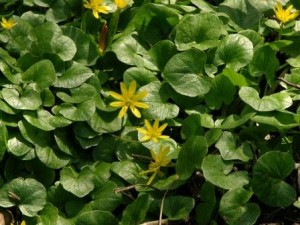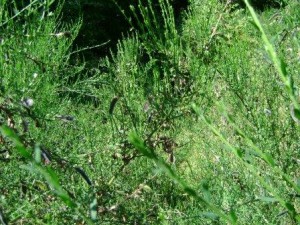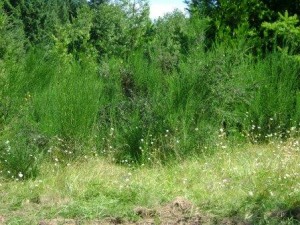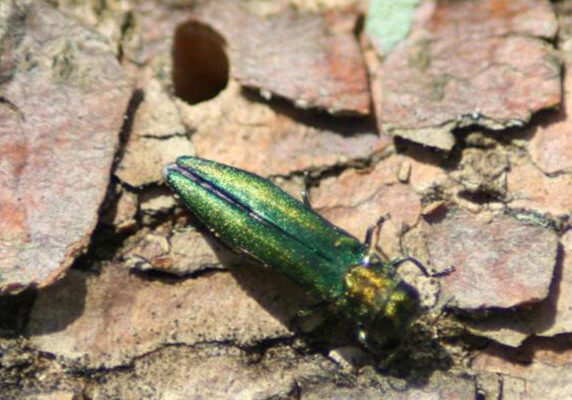With the intermittent rain and sun that characterizes a Portland spring, comes not only the blooming of many of our native plants, but also many of the invasive weeds that plague our landscapes. Three of the most prominant weeds to manage this time of year are lesser celandine, spurge laurel and Scotch broom.
 |  |
| Lesser celandine | Spurge laurel |
 |  |
| Scotch broom | Scotch broom in field |
Lesser celandine (Ficaria verna)
Lesser celandine is an herbaceous perennial in the buttercup family. Plants have a basal rosette of dark green, shiny, kidney-to-heart-shaped leaves. Yellow flowers bloom in March and April and have eight glossy petals on single delicate stalks. Pale bulblets appear on the stems. Lesser celandine spreads quickly by producing many turions on the roots, which survive for years and are easily spread by water and when soil is disrupted.
Lesser celandine prefers shade to partial shade but can easily survive in full sun with enough water. Plants can take over a forest understoryUnderstory The area under and around trees and form a monocultureMonoculture A single type of plant growing in an area. by forcing out native forbs and early-blooming wildflowers.
To control, dig up the plants and sift the soil to make sure you get all the bulblets. For chemical control, see guidance the 4-County Cooperative Weed Management Area factsheets.
Read more guidance and EPA information on Glyphosate.
Spurge laurel (Daphne laureola)
Spurge laurel is a slow-growing, shade-tolerant, evergreen shrub from Europe and the Mediterranean that has escaped from gardens. It likes full to part shade and well-drained soil. Its berries are spread by birds and rodents but it can also spread by root sprouts. The berries, leaves and bark are poisonous to humans, cats and dogs and handling the plant can cause contact dermatitis. Once established, spurge laurel is very hard to get rid of.
It’s found in isolated clumps, but can grow 2-4 feet tall. The leaves are dark green, shiny and thick and densely whorled near the top of the stem. Small light-green flowers with orange stamens appear from late January to late March; they are highly fragrant at night to attract moths.
It’s best to hand pull younger plants and use a weed wrench for the larger plants. Be sure to wear gloves when handling the plant. You want to get all the roots to avoid re-growth.
Brooms and Gorse (Cytisus scorparius, C. striatus, Spartium junceum, Genista monspessulana and Ulex europaeus)
Brooms, such as Scots broom and gorse are perennial evergreen shrubs that bloom in April-June. They have many slender, erect, dark green angled branches with small, simple leaves and lots of small, pea-shaped flowers. Gorse has distinctive 1 inch thick spines.
They will displace native plants and increase the costs of timber production by invading disturbed sites, natural areas, dune and public/private forest lands. The seeds live over 50 years and mature plants produce a lot of seeds requiring long-term maintenance.
Mow prior to April 15 but not when the pods are ripe with seed. Pull the smaller plants by hand or with a weed wrench. Cut back larger plants and dig out the roots. Mid-to-late summer cutting is best when the plant is stressed. There are three biological control agents; a beetle, a seed weevil and a twig miner are approved for release and have been established in Oregon.
Prevention is the key!



